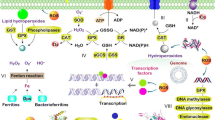Abstract
The possible role of the heat-shock protein 90 (Hsp90) complex on the heat-shock (HS) response in yeast using the Hsp90 inhibitors geldanamycin (GA) and 17-allylamino-17-demethoxygeldanamycin (AAG), and prednisolone and 17β-estradiol as modulators was investigated. Following long- or short-term administration of the drugs, either alone or in combination, the response was determined as cell viability and growth after exposure to HS. Upon short-term preconditioning, both Hsp90 inhibitors conferred cycloheximide-dependent thermal resistance to the yeast cultures, while upon long-term treatment the induction of thermotolerance was confined only to AAG. Co-administration of prednisolone or 17β-estradiol failed to significantly alter the response to Hsp90 inhibitors. However, since short-term incubation with prednisolone alone induced thermotolerance, increased the budding cell fraction and tended to reduce the adaptive response to GA, its effect on GA-induced thermotolerance is not yet explained. Generally, GA and AAG showed a comparable short-term action but a different long-term effect on the HS response in yeast; this response was not related to any regulation by prednisolone or 17β-estradiol (while 17β-estradiol was unable to modify the response, the action of prednisolone in both the stress response and the cell cycle was equivocal).
Similar content being viewed by others
Abbreviations
- AAG:
-
17-allylamino-17-demethoxygeldanamycin
- CFU:
-
colony-forming units
- Cxm:
-
cycloheximide
- GA:
-
geldanamycin
- HS:
-
heat shock
- Hsp90:
-
heat-shock protein 90
References
Beliakoff J., Bagatell R., Paine-Murrieta G., Taylir C.W., Lykkesfeldt A.E., Whitesell L.: Hormone-refractory breast cancer remains sensitive to the antitumor activity of heat-shock protein 90 inhibitors.Clin.Cancer Res. 9, 4961–4971 (2003).
Borkovich K.A., Farrelly F.W., Finkelstein D.B., Taulien J., Lindquist S.: Hsp82 is an essential protein that is required in higher concentrations for growth of cells at higher temperatures.Mol.Cell.Biol. 9, 3919–3930 (1989).
Burshell A., Stathis P.A., Do Y., Miller S.C., Feldman D.: Characterization of an estrogen-binding protein in the yeastSaccharomyces cerevisiae.J.Biol.Chem. 259, 3450–3456 (1984).
Delitheos A., Karavokyros I., Tiligada E.: Response ofSaccharomyces cerevisiae strains to antineoplastic agents.J.Appl.Bacteriol. 79, 379–383 (1995).
Duina A.A., Kalton H.M., Gaber R.F.: Requirement for Hsp90 and a CyP-40-type cyclophilin in negative regulation of the heatshock response.J.Biol.Chem. 273, 18974–18978 (1998).
Goetz M.P., Toft D.O., Ames M.M., Erlichman C.: The Hsp90 chaperone complex as a novel target for cancer therapy.Ann.Oncol. 14, 1169–1176 (2003).
Knoblauch R., Garabedian J.: Role for Hsp90-associated cochaperone p23 in estrogen receptor signal tranduction.Mol.Cell.Biol. 19, 3748–3759 (1999).
Liu X.D., Morano K.A., Thiele D.J.: The yeast Hsp110 family member, Sse1, is an Hsp90 cochaperone.J.Biol.Chem. 274, 26654–26660 (1999).
Maloney A., Workman P.: Hsp90 as a new therapeutic target for cancer therapy: the story unfolds.Expert Opin.Biol.Ther. 2, 3–24 (2002).
Miligkos V., Tiligada E., Papamichael K., Ypsilantis E., Delitheos A.: Anticancer drugs as inducers of thermotolerance in yeast.Folia Microbiol. 45, 339–342 (2000).
Piper P.W., Millson S.H., Mollapour M., Panaretou B., Siligardi G., Pearl L.H., Prodromou C.: Sensitivity to Hsp90-targeting drugs can arise with mutation to the Hsp90 chaperone, cochaperones and plasma membrane ATP binding cassette transporters of yeast.Eur. J.Biochem. 270, 4689–4695 (2003).
Schena M., Yamamoto K.R.: Mammalian glucocorticoid receptor derivatives enhance transcription in yeast.Science 241, 965–967 (1988).
Stavrinidis E., Delitheos A., Tiligada E.: Induction of morphological alterations by antineoplastic agents in yeast.Folia Microbiol. 47, 157–160 (2002).
Tiligada E., Giannakakou P., Karavokyros I., Delitheos A.: Effect of calcium channel blockers on the action of various antitumor agents in the yeastSaccharomyces cerevisiae.J.Appl.Bacteriol. 81, 481–485 (1996).
Tiligada E., Stavrinidis E., Delitheos A.: Effect of tamoxifen in lower eukaryotic cells.Anticancer Res. 17, 4098–4099 (1997).
Tiligada E., Miligkos V., Ypsilantis E., Papamichael K., Delitheos A.: Molybdate induces thermotolerance in yeast.Lett.Appl. Microbiol. 29, 77–80 (1999).
Tiligada E., Miligkos V., Delitheos A.: Cross-talk between cellular stress, cell cycle and anticancer agents: mechanistic aspects.Curr.Med.Chem.Anti-Canc.Agents 2, 553–566 (2002).
Vovou I., Delitheos A., Tiligada E.: The heat-shock response is dependent on the external environment and on rapid ionic balancing by pharmacological agents inSaccharomyces cerevisiae.J.Appl.Microbiol. 96, 1271–1277 (2004).
Zhang X., Essmann M., Burt E.T., Larsen B.: Estrogen effects onCandida albicans: a potential virulence-regulating mechanism.J.Infect.Dis. 181, 1441–1446 (2000).
Author information
Authors and Affiliations
Corresponding author
Additional information
This work was financially supported by theUniversity of Athens, Greece.
Rights and permissions
About this article
Cite this article
Papamichael, K., Vovou, I., Miligkos, V. et al. Effect of the Hsp90 modulators on the heat-shock response in eukaryotic cells. Folia Microbiol 51, 33–37 (2006). https://doi.org/10.1007/BF02931447
Received:
Revised:
Issue Date:
DOI: https://doi.org/10.1007/BF02931447




